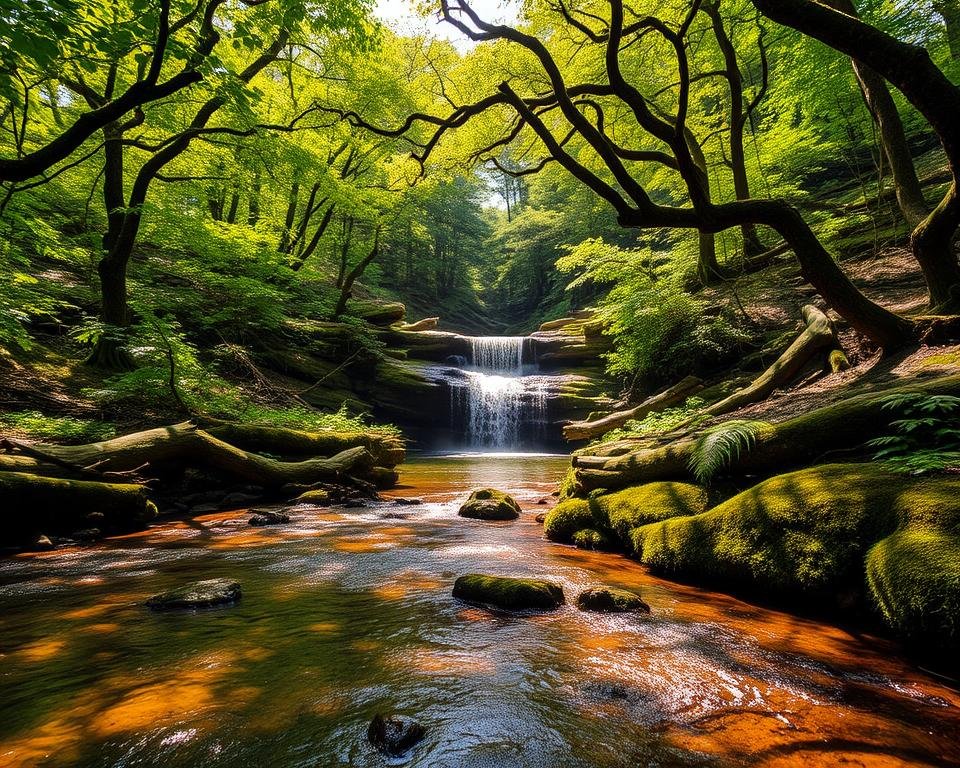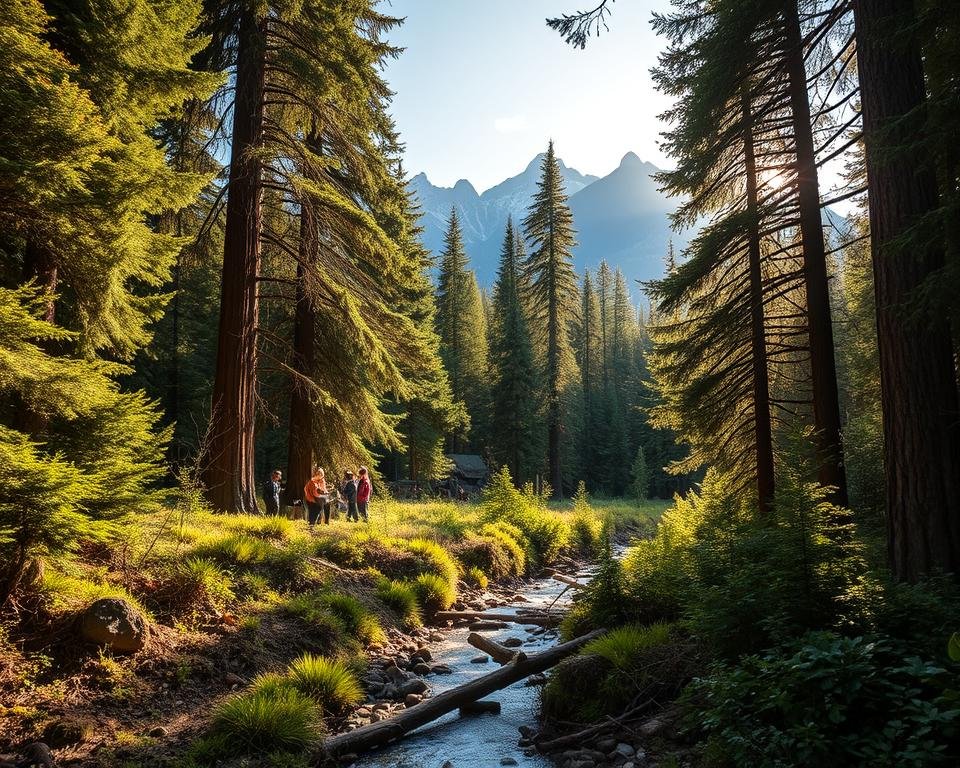Anúncios
Did you know that forests cover about 30% of the Earth’s landmass? They provide a home for a huge variety of life. As we explore the principles governing forest ecosystems, you’ll learn more about these important places.
Anúncios
Learning about forest ecology helps us see why we must protect our natural world. By diving into the main principles, you’ll get a full picture of this interesting subject. It’s key to keeping our planet healthy.
Key Takeaways
- Forests are complex ecosystems that support a wide range of plant and animal species.
- The principles of forest ecology help us understand the interactions within these ecosystems.
- Preserving forests is key for keeping biodiversity and ecological balance.
- Forest ecosystems offer many benefits, like clean air and water.
- Understanding forest ecology is vital for effective conservation efforts.
Understanding Forest Ecosystems
Forest ecosystems are complex, with many parts working together. This includes trees, plants, animals, and tiny organisms. Each part is important for the ecosystem’s health and strength.
Definition of a Forest Ecosystem
A forest ecosystem is a network of living things and their environment. This balance supports a wide range of life. It includes trees, plants below the trees, animals, fungi, and tiny soil organisms.
Anúncios
Forest ecosystems can last for a long time. They work together through photosynthesis, nutrient cycles, and predator-prey relationships.
Components of Forest Ecosystems
Forest ecosystems have living and non-living parts. Living parts are trees, plants, animals, and tiny organisms. Non-living parts are soil, water, sunlight, and temperature.
- Canopy and Understory: The canopy layer affects the microclimate and light. The understory has smaller plants that grow in less light.
- Soil and Microorganisms: Soil is key for nutrients and home for tiny organisms. They help with nutrient cycles and breaking down organic matter.
- Wildlife: Animals help with seed dispersal, controlling populations, and nutrient cycling. They add to the ecosystem’s variety.
Importance of Biodiversity
Biodiversity is essential for forest ecosystems. It keeps the ecosystem healthy and strong. A diverse ecosystem can handle challenges better, like diseases and climate change.
| Biodiversity Component | Role in Ecosystem | Benefits |
|---|---|---|
| Species Diversity | Variety of plants and animals | Ecosystem resilience, nutrient cycling |
| Genetic Diversity | Variety within species | Adaptability to changing conditions |
| Ecosystem Diversity | Variety of ecosystems | Supports different species, ecological processes |
Keeping forest biodiversity safe is key. It helps with clean water, air, and soil. It also supports climate regulation and carbon capture.
The Role of Trees in Forest Ecology
Trees are vital for keeping forest ecosystems in balance. They are the foundation of these ecosystems, giving many benefits to plants and animals.
Photosynthesis and Energy Flow
Trees are key in photosynthesis, turning sunlight into energy for other living things. This energy is vital for the ecosystem’s food chain and biodiversity.
Through photosynthesis, trees make energy and oxygen. Oxygen is key for nearly all life. The energy in trees helps feed other animals and plants.
Key aspects of photosynthesis and energy flow include:
- Conversion of sunlight into chemical energy
- Production of oxygen as a byproduct
- Support for the food chain through energy transfer
Carbon Storage and Climate Regulation
Trees absorb carbon dioxide and store it in their biomass and soil. This helps control the climate by reducing greenhouse gases, fighting climate change.
Sustainable forest management is key to keeping forests as carbon sinks. Responsible harvesting and regeneration help forests store more carbon.
Tree Diversity and Resilience
Having many tree species in a forest makes it resilient. Each species adds unique traits, like different roots and leaves, helping the forest adapt to changes.
A diverse forest can better handle threats like pests and extreme weather. By supporting tree diversity, we make forests healthier and more resilient.
- Promoting mixed-species forests
- Maintaining genetic diversity within tree species
- Protecting old-growth forests
Soil Composition and Health
Healthy soil is key to forest ecosystems. It supports the health of trees and other organisms. Soil composition and health are vital for the balance of these ecosystems.
Importance of Soil Microorganisms
Soil microorganisms are vital for breaking down organic matter and cycling nutrients. They also help with forest carbon sequestration. These tiny helpers are essential for tree health and the ecosystem’s well-being.
- Decomposition of organic matter
- Nutrient cycling
- Carbon storage
The variety of soil microorganisms is key to ecosystem services. They support decomposition, releasing nutrients that trees need to grow.
Nutrient Cycling in Forests
Nutrient cycling is vital in forest ecosystems, influenced by soil health. It involves the exchange of nutrients between soil, trees, and other organisms.
- Nutrient uptake by trees
- Decomposition and release of nutrients
- Nutrient storage in soil organic matter
Good nutrient cycling keeps forests productive and resilient. It’s linked to forest carbon sequestration, as healthy soils can hold more carbon.
Impacts of Erosion and Degradation
Soil erosion and degradation harm forest ecosystems. They cause the loss of fertile soil, decrease biodiversity, and lower water quality.
The effects include:
- Loss of fertile topsoil
- Decreased soil water-holding capacity
- Reduced forest productivity
Keeping soil healthy through sustainable practices is vital. It helps preserve forest ecosystems and their carbon sequestration abilities.
Water Cycle Dynamics in Forests
Understanding the water cycle in forests is key to managing them well. Trees and plants help keep water balanced in these ecosystems.

Forests and Hydrology
Forests and water work together in a complex way. This includes processes like rain, water soaking into the ground, and plants releasing water vapor. Trees help control water flow by absorbing and storing it.
Evapotranspiration is important in forest water management. Trees release water vapor, which affects the local weather. This helps keep forests healthy and supports many species.
Effects of Deforestation on Water Flow
Deforestation messes with the water cycle, changing how water flows and its quality. Without trees, areas are more likely to flood and erode.
Removing trees also harms water in rivers and streams. More runoff means more sediments and pollutants. This shows why keeping forests is key to good water cycles.
Importance of Wetlands and Riparian Zones
Wetlands and riparian zones are vital in forests. They support many plants and animals. These areas clean water by filtering out pollutants and sediments.
They also control water flow, helping to prevent floods. Keeping these areas healthy is essential for forest ecosystems. It supports forest succession patterns and helps forests thrive.
Interactions Among Forest Species
Understanding how forest species interact is key to seeing the beauty of forest biodiversity. These interactions are complex and involve many relationships. They are vital for the ecosystem’s balance and health.
Competition and Cooperation
In forest ecosystems, species interact in many ways, like competing and cooperating. Competition for resources like light, water, and nutrients is a key part of forest life. Trees, for example, compete for sunlight, leading to a layered canopy with different species in each layer. Cooperation, on the other hand, helps species survive and thrive. For instance, mycorrhizal fungi help trees by taking in nutrients and keeping them healthy.
Predation and Herbivory Relationships
Predation and herbivory are key in forest ecosystems, controlling species populations. Predators like wolves and hawks keep herbivore numbers in check, preventing overgrazing. Herbivores, in turn, shape plant communities by choosing which plants to eat. This balance between predators, herbivores, and plants shapes the forest and keeps biodiversity high.
Symbiotic Relationships in Forests
Symbiotic relationships are common in forests, where species live together for mutual benefit or no harm. Mycorrhizal associations between fungi and tree roots are a great example, helping trees absorb nutrients and grow. Other examples include nitrogen-fixing bacteria and legume roots, which make soil more fertile.
| Type of Interaction | Description | Example |
|---|---|---|
| Competition | Species competing for the same resources | Trees competing for sunlight |
| Cooperation | Species working together for mutual benefit | Mycorrhizal fungi and tree roots |
| Predation | One species preying on another | Wolves preying on deer |
| Symbiosis | Mutually beneficial or neutral relationships between species | Nitrogen-fixing bacteria and legume roots |
These interactions show the complexity and connection of forest ecosystems. By understanding and protecting these relationships, we can preserve forest biodiversity and keep these ecosystems healthy.
The Impact of Climate Change
As global temperatures rise, forests face big challenges. Climate change messes with the balance in these ecosystems. It affects trees and all life that depends on them.
Temperature and Precipitation Changes
Rising temperatures and changing rain patterns hurt forest health. Warmer weather can cause drought, while rain changes can lead to too much water or not enough. Both can harm forests.
Forests are very sensitive to temperature and moisture changes. Some trees do well in warmer weather, while others struggle. Knowing this helps us manage forests better.
Effects on Species Distribution
Climate change is changing where different species live in forests. As it gets warmer, many species move to cooler places. This can change who lives where and upset the ecosystem balance.
For example, some birds are moving north, changing forest bird communities. Plants and trees are also moving, with some growing their ranges and others shrinking.
Role of Forests in Mitigating Change
Forests are key in fighting climate change. They soak up CO2 from the air through photosynthesis. This helps reduce greenhouse gases and slow warming.
According to the USDA Climate Hubs, forests are essential in the fight against climate change. Good forest management can help forests store more carbon, making them stronger against climate change.
| Forest Type | Carbon Storage Capacity | Resilience to Climate Change |
|---|---|---|
| Tropical Forests | High | Moderate |
| Temperate Forests | Moderate | High |
| Boreal Forests | High | Low |
By understanding climate change’s impact on forests and using sustainable management, we can help. This ensures our forests stay healthy and strong for the future.
Human Activities Affecting Forests
Human actions are harming forests, and we need to act fast. Forests are more than just trees. They help us by cleaning the air, supporting life, and keeping our water clean.
Things like cutting down forests, changing land use, and building cities are hurting these ecosystems. Deforestation is a big problem. It destroys homes for animals and messes with the weather. Every year, millions of hectares of forest are lost for farming, cities, and logging.
Deforestation and Land Use
Deforestation is a big issue, mainly because of farming and cities. Turning forests into farms hurts animals and the air we breathe. Forests help keep the air clean by absorbing carbon dioxide. When we cut them down, this carbon is released, making the climate worse.
Urbanization and Fragmentation
As cities grow, forests get broken up. This isolates animals and messes with nature’s balance. This can make forests less diverse and less able to recover.
Planning cities with green spaces can help. Also, using sustainable forestry practices is important. This means taking care of forests while using their resources.
Sustainable Forestry Practices
Sustainable forestry means managing forests well. This includes picking trees carefully, planting new ones, and keeping paths for animals. Sustainable forest management helps forests keep their benefits, like forest carbon sequestration, and supports local jobs.
| Practice | Description | Benefits |
|---|---|---|
| Selective Logging | Logging specific trees while leaving others intact | Maintains forest structure, reduces impact on biodiversity |
| Reforestation | Planting trees in areas where forests have been degraded or cleared | Restores ecosystem services, enhances carbon sequestration |
| Ecological Corridors | Maintaining connectivity between forest patches | Enhances biodiversity, facilitates species migration |
In conclusion, our actions are hurting forests, but we can change this. By using sustainable forest management and conservation, we can protect these vital ecosystems. It’s key to find a balance between using forest resources and keeping them healthy for the future.
Conservation Strategies for Forest Ecosystems
Keeping forests healthy is key. We face challenges like climate change and losing biodiversity. It’s important to use many methods and involve everyone.

Protecting Endangered Species
Protecting endangered species is vital. We need to find out which species are at risk and what threatens them. Habitat preservation and restoration are important steps.
Creating safe places like national parks helps endangered species. Also, bringing back extinct species can balance ecosystems.
“The loss of biodiversity is a critical issue that threatens the health of our planet. Protecting endangered species is not just a moral imperative, but also essential for maintaining the resilience of ecosystems.”
Implementing Reforestation Initiatives
Reforestation is key for forest conservation. Planting trees in deforested or degraded areas helps ecosystems and biodiversity. It also helps fight climate change by absorbing carbon.
For reforestation to work, we must plant the right trees and take care of them. This means choosing trees that fit the local area and working with local people.
- Selecting native tree species
- Engaging local communities
- Ensuring proper management and maintenance
Community Involvement in Conservation
Local communities are vital for forest conservation. They can help protect forests by joining in conservation efforts and sharing their knowledge.
Working with local communities helps find solutions that meet both human needs and conservation goals. This teamwork makes conservation more effective and lasting.
| Conservation Strategy | Benefits |
|---|---|
| Protecting Endangered Species | Maintains biodiversity, promotes ecological balance |
| Reforestation Initiatives | Restores ecosystem functions, promotes carbon sequestration |
| Community Involvement | Enhances conservation effectiveness, balances human needs with conservation goals |
Future Trends in Forest Ecology Research
Forest ecology research is set to change a lot, thanks to new tech and a better grasp of ecosystems. Knowing how forests work is key to managing them well.
Ecological Monitoring Innovations
New ways to monitor nature will help us understand forests better. This will lead to better ways to protect and manage them.
Advances in Carbon Sequestration
Studying how forests soak up carbon will help fight climate change. Scientists will learn more about how forests store carbon.
Technology in Conservation
Technology will be a big help in saving forests. It will give us new tools to care for and keep forests safe for the future.
